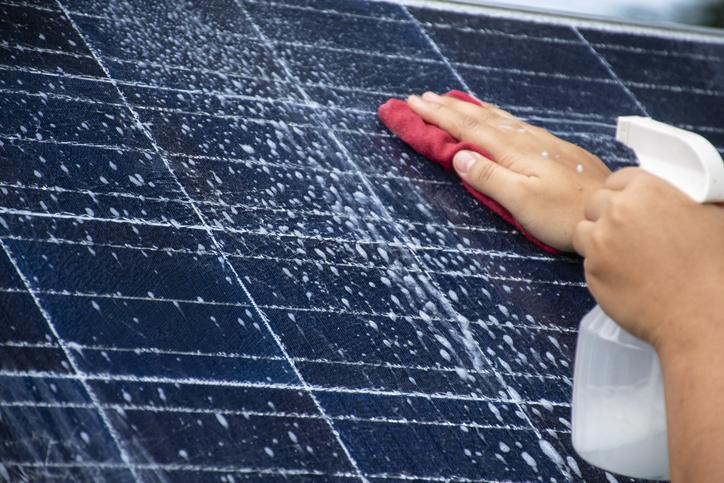Solar panels are an excellent way to reduce energy costs and decrease your carbon footprint. However, to ensure they continue operating at maximum efficiency, regular cleaning is essential. Over time, dust, dirt, pollen, bird droppings, and debris can accumulate on the panels, which can block sunlight and reduce energy production. In this guide, we’ll walk you through the steps to properly clean your system and maintain its efficiency for the long term.
Why Cleaning Solar Panels is Important
Solar panels work by converting sunlight into electricity, and any obstruction between the surface and the sun can diminish this process. Studies have shown that dirty glass can lose up to 20% of its efficiency, depending on the severity of the buildup. Regular cleaning helps maximize energy production, ensuring you get the most out of your investment. For best results, follow the maintenance recommendations from leading providers of solar panels.
The ideal time to clean your solar panels depends on several factors, including the climate and location of your home. If you live in an area with heavy pollution, frequent dust storms, or a lot of bird activity, more frequent cleaning may be necessary. As a general rule, cleaning your system every six months is a good practice.
Before cleaning, it’s a good idea to visually inspect your panels. If you notice visible dirt, grime, or bird droppings, it’s time to give them a good cleaning. Additionally, most systems come with monitoring software that tracks their efficiency. If you see a sudden drop in energy production, this could also indicate that your glass needs cleaning.
Eco-friendly living doesn’t have to be hard, and cleaning your solar panels doesn’t require special tools or harsh chemicals. In fact, the process is relatively simple if done correctly. Follow these steps to clean your system safely and effectively:
Before you begin, prioritize safety. Cleaning solar panels often involves working on the roof, so it's important to take necessary precautions. Use a sturdy ladder, wear non-slip shoes, and avoid cleaning on rainy or windy days when the surface can be slippery. If you are uncomfortable working at heights, consider hiring a professional.
Also, ensure that the system is turned off before cleaning; although it is made to withstand exposure to the elements, water combined with electricity can be dangerous. Check your manual for instructions on how to safely power down the system before cleaning.
The best time to clean your system is early in the morning or late in the evening when the panels are cool. Cleaning during peak sunlight hours when the glass is hot can cause water to evaporate quickly, leaving streaks or even doing damage. Additionally, cleaning in the cool hours of the day makes the task safer and more comfortable.
You don’t need any fancy equipment to clean solar panels. In most cases, a garden hose with a nozzle attachment will suffice for rinsing off dust and loose debris. For more thorough cleaning, use a soft sponge or non-abrasive brush with a long handle to reach without walking on them.
Avoid using harsh cleaning agents, as these can damage the protective coating on the panels. Stick to mild, biodegradable soap if necessary. Remember, the goal is to remove dirt without scratching or causing damage.
Start by gently rinsing the glass with a garden hose to remove loose dirt, dust, and debris. Be careful not to use high-pressure water, as it can damage the panels or wiring.
Next, fill a bucket with clean water and add a small amount of mild soap if needed. Dip your sponge or brush in the soapy water and gently scrub the surface. Pay extra attention to areas with bird droppings or stubborn grime, but avoid scrubbing too hard, as this can scratch the surface.
Once you’ve scrubbed the panels, use the hose to rinse them off thoroughly. Make sure no soap residue is left behind, as this can affect the overall efficiency.
While air drying is usually sufficient, you can use a soft squeegee or lint-free cloth to remove excess water and prevent streaking. Avoid using any materials that might scratch the panels.
After cleaning, take a moment to inspect the area around your solar panels. Trim back any overhanging branches or plants that may be casting shadows and reducing effectiveness. Keeping the surrounding area clear ensures maximum sunlight exposure.
Once your panels are clean and dry, monitor their performance to ensure they are back to peak efficiency. Most systems come with software that tracks energy production. If you notice any significant issues after cleaning, such as cracks or drops in efficiency, it may be a good idea to schedule a professional inspection.
Cleaning your solar panels is a simple yet essential task that helps ensure long-term efficiency and performance. By following these steps and incorporating regular cleanings into your maintenance routine, you can keep your system operating at its best. Not only will clean glass provide more energy, but it will also prolong the lifespan of your investment, saving you money in the long run. If you’re ever in doubt or unable to clean your panels safely, don’t hesitate to reach out to a professional technician.